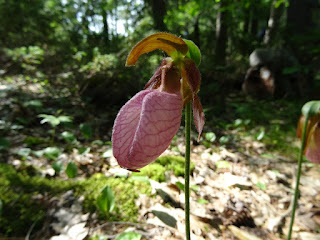Lot's of Eastern Massasauga among the rock barrens, this was the first of the weekend. The haze on the eyes indicates that this one will soon shed it's skin.
A scan of the rocky islands often yielded good numbers of Map Turtles basking.
Common Mergansers, I didn't spot a tonne of waterfowl over the course of the weekend but it was nice to hear the recurring call of Black-throated Greens for hours on end.
A solitary female Little Brown Myotis was spotted in direct sunlight on the rocks, handled here by an MNRF bat biologist this one showed mild signs of wear on the base of the wings which is caused by white nose syndrome.
A favourite of many, Hog-nosed Snake. This one flared it's neck out but didn't go all out with the 'play dead' display that the species is known to do to keep predators at bay.
This Foxsnake was spotted twice over the course of the weekend, unique as a reult of several scars and markings on it's body.
I bid my beloved (holed-filled and slick soled) hiking boots one last hurray wading chest deep into this lily pad marsh in search of Musk Turtles.
And yes, they live up to the name Musk Turtle or Stinkpot, hooo-wee.
In addition to Northern Leopard Frog, there were Wood Frog, Spring Peeper and American Bullfrog calling.
A nice spot to look for Blanding's Turtle.
This female opted for laying her eggs on the shoreline, check out that leech!
Ring-necked Snake was found taking shelter beneath a well-placed piece of sheet metal on a rock outcrop.
Red-backed Salamanders could be found beneath many of the rocks and logs throughout the deciduous forests and mixed swamps.
And just as my weekend started with a Massasauga, I spotted this one coiled up among a thicket of Leatherleaf during a rainstorm.
The skies were abuzz with Common Baskettail, at times maybe 20-30 swarming above my head (picking off some of the abundant mosquitoes).
Chalk-fronted Corporal
The exuviae of one of the recently transformed dragonflies, some were quite sluggish, pale and had likely 'hatched' hours or minutes before.
AGreen Rose Chafer beetle (Cetonia aurata) foraginf on Spirea
Pink Lady's Slipper (Cypripedium acaule). These were actually quite abundant and at the peak of their bloom.
Wavy Hairgrass (Deschampsia flexulosa) is common on the barrens.
I did well to keep my mind focused on herps, but the flora of the granitic barrens called out and on the last day of the course I spent my 10 minute lunch botanizing an area at the north end of the island while the group chatted away. I got razzed upon my return, but as it turns out, I came up with a couple of really great sedges.
The first, Clustered Sedge (Carex cumulata) is regionally rare for the Frontenac Axis region. Each time I delve into the Ovales group the trusty microscope makes things much much easier in working through keys.
A few clumps of the more-familiar Inland Sedge (Carex interior)
This sedge stuck out, something about the drooping nature of it and the form of the lighter-coloured spikes ...
It wasn't until I was back home looking in closer detail that I confirmed it to be Emmons' Sedge (Carex albicans var. emmonsii)! This species is ranked an S2 with only 2 or 3 records for the Georgian Bay area. What a great spot!






























Nice work man! Glad you got to see some cool plants in addition to the herps. I hear you even had a sighting of the Waterloo Wattler.
ReplyDelete